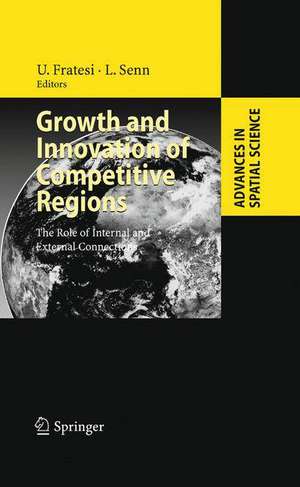Growth and Innovation of Competitive Regions: The Role of Internal and External Connections: Advances in Spatial Science
Editat de Ugo Fratesi, Lanfranco Sennen Limba Engleză Hardback – 19 dec 2008
| Toate formatele și edițiile | Preț | Express |
|---|---|---|
| Paperback (1) | 947.67 lei 6-8 săpt. | |
| Springer Berlin, Heidelberg – 22 noi 2010 | 947.67 lei 6-8 săpt. | |
| Hardback (1) | 956.81 lei 6-8 săpt. | |
| Springer Berlin, Heidelberg – 19 dec 2008 | 956.81 lei 6-8 săpt. |
Din seria Advances in Spatial Science
-
 Preț: 368.91 lei
Preț: 368.91 lei - 18%
 Preț: 963.47 lei
Preț: 963.47 lei - 18%
 Preț: 948.16 lei
Preț: 948.16 lei - 18%
 Preț: 947.67 lei
Preț: 947.67 lei - 18%
 Preț: 940.72 lei
Preț: 940.72 lei - 18%
 Preț: 954.45 lei
Preț: 954.45 lei - 15%
 Preț: 646.62 lei
Preț: 646.62 lei - 18%
 Preț: 959.50 lei
Preț: 959.50 lei - 18%
 Preț: 956.33 lei
Preț: 956.33 lei - 18%
 Preț: 949.23 lei
Preț: 949.23 lei - 15%
 Preț: 646.75 lei
Preț: 646.75 lei - 15%
 Preț: 643.99 lei
Preț: 643.99 lei - 18%
 Preț: 955.40 lei
Preț: 955.40 lei - 15%
 Preț: 643.00 lei
Preț: 643.00 lei - 15%
 Preț: 644.49 lei
Preț: 644.49 lei - 18%
 Preț: 953.35 lei
Preț: 953.35 lei - 18%
 Preț: 956.03 lei
Preț: 956.03 lei - 15%
 Preț: 647.27 lei
Preț: 647.27 lei - 15%
 Preț: 638.24 lei
Preț: 638.24 lei - 18%
 Preț: 961.23 lei
Preț: 961.23 lei - 18%
 Preț: 954.93 lei
Preț: 954.93 lei - 15%
 Preț: 643.48 lei
Preț: 643.48 lei - 18%
 Preț: 955.70 lei
Preț: 955.70 lei - 15%
 Preț: 650.86 lei
Preț: 650.86 lei - 15%
 Preț: 650.04 lei
Preț: 650.04 lei - 15%
 Preț: 648.42 lei
Preț: 648.42 lei - 18%
 Preț: 949.42 lei
Preț: 949.42 lei - 18%
 Preț: 960.30 lei
Preț: 960.30 lei - 18%
 Preț: 948.29 lei
Preț: 948.29 lei - 18%
 Preț: 958.07 lei
Preț: 958.07 lei - 18%
 Preț: 950.66 lei
Preț: 950.66 lei - 18%
 Preț: 956.03 lei
Preț: 956.03 lei - 15%
 Preț: 643.65 lei
Preț: 643.65 lei - 18%
 Preț: 956.99 lei
Preț: 956.99 lei - 18%
 Preț: 956.81 lei
Preț: 956.81 lei - 18%
 Preț: 958.73 lei
Preț: 958.73 lei - 18%
 Preț: 959.98 lei
Preț: 959.98 lei - 18%
 Preț: 952.40 lei
Preț: 952.40 lei - 15%
 Preț: 643.00 lei
Preț: 643.00 lei
Preț: 956.81 lei
Preț vechi: 1166.84 lei
-18% Nou
Puncte Express: 1435
Preț estimativ în valută:
183.09€ • 191.55$ • 152.09£
183.09€ • 191.55$ • 152.09£
Carte tipărită la comandă
Livrare economică 02-16 aprilie
Preluare comenzi: 021 569.72.76
Specificații
ISBN-13: 9783540709237
ISBN-10: 3540709231
Pagini: 380
Ilustrații: IX, 368 p.
Dimensiuni: 155 x 235 x 24 mm
Greutate: 0.77 kg
Ediția:2009
Editura: Springer Berlin, Heidelberg
Colecția Springer
Seria Advances in Spatial Science
Locul publicării:Berlin, Heidelberg, Germany
ISBN-10: 3540709231
Pagini: 380
Ilustrații: IX, 368 p.
Dimensiuni: 155 x 235 x 24 mm
Greutate: 0.77 kg
Ediția:2009
Editura: Springer Berlin, Heidelberg
Colecția Springer
Seria Advances in Spatial Science
Locul publicării:Berlin, Heidelberg, Germany
Public țintă
ResearchCuprins
Foundations of Growth in Interconnected Territories.- Regional Growth, Connections and Economic Modelling: An Introduction.- Sustainable Interrelated Growth: A Phenomenal Approach.- A Model of Local Development.- The Dynamics of an ‘Innovation Driven’ Territorial System.- Innovation and Entrepreneurship in Regions Faced with External Competition.- The Co-Evolution of Entrepreneurship and Clusters.- Learning, Innovation and Growth Within Interconected Clusters: An Agent-Based Approach.- Knowledge-Based Economy and Knowledge Creation: The Role of Space.- Systems of Innovation and Regional Growth in the EU: Endogenous vs. External Innovative Activities and Socio-Economic Conditions.- Some Conjectures on the Tie Between Digital Divide and Regional Disparities.- The Factors of Development in Advanced Regions.- Interconnection-Infrastructure as a Prerequisite for the Development of Territories — The Role of Network Externalities.- Regional Growth and the Co-Evolution of Clusters: The Role of Labour Flows.- Intra-National Disparities, Regional Interactions and the Growth of Countries.- Creativity, Cultural Investment and Local Development: A New Theoretical Framework for Endogenous Growth.- Methods and Theories for the Study of Interconnected Territories.- Modelling Individual Behaviour of Firms in the Study of Spatial Concentration.- The New Approach to Regional Economics Dynamics: Path Dependence and Spatial Self-Reinforcing Mechanisms.- Conclusions.- What Policy for Interconnected Territories? Conclusions and Openings.
Recenzii
From the reviews:
“The book has sixteen chapters grouped in five parts, and covers a wide range of topics in regional economics, innovation, and regional growth, and with varied approaches. … The editors and contributors have made a great effort to link the majority of the essays with each other. … Summing up, their book is a very useful one for empirical economists who need some theoretical background in dealing with regional innovation from an applied perspective, and it is also an important theoretical contribution to regional science.” (Ernest Miguelez and Rosina Moreno, Journal of Regional Science, Vol. 51 (1), 2011)
“The book has sixteen chapters grouped in five parts, and covers a wide range of topics in regional economics, innovation, and regional growth, and with varied approaches. … The editors and contributors have made a great effort to link the majority of the essays with each other. … Summing up, their book is a very useful one for empirical economists who need some theoretical background in dealing with regional innovation from an applied perspective, and it is also an important theoretical contribution to regional science.” (Ernest Miguelez and Rosina Moreno, Journal of Regional Science, Vol. 51 (1), 2011)
Textul de pe ultima copertă
This volume investigates the dynamics of regional performance in advanced countries and the mechanisms that allow some regions to grow more rapidly than others, to become and remain more competitive in the long run. The authors show how the capability of regions to innovate is enhanced by a large number of factors, including entrepreneurship, clustering, creativity, new technologies, human capital and the presence of internal, intra-regional, and external, extra-regional, connections. The book is mainly theoretical, but all chapters also analyze the policy consequences. Moreover, the empirical results reinforce the theoretical findings and as such are more broadly applicable and not bound to the specific case. The general reach of the theoretical arguments, and the focus on policy consequences, make this book helpful for both scholars and policymakers.
Caracteristici
Includes supplementary material: sn.pub/extras
















